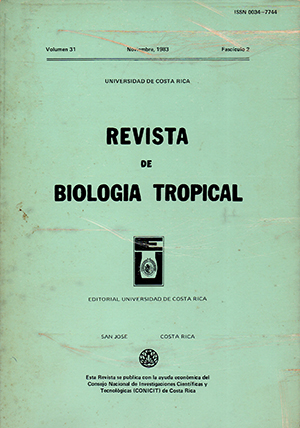Abstract
Several striking secondary sexual characters of the weevil Rhinostomus barbirostris serve as weapons in intraspecific battles between males for females about to oviposit. Smaller males adopt two alternative behavioral tactics in these battles which seem designed to minimize the loss in reproduction which would otherwise result from their inferior fighting abilities. Although the beetles may thus be polymorphic for fighting behavior, there was no sign of morphological dimorphisms. The sizes of their weapons (long rostra) were linearly rather than geometrically related to the sizes of other body parts. The males' behavior suggests that there is strong sperm precendence in this species.References
Arrow, G. 1951. Horned Beetles: a study of the fantastic in nature. Dr. W. Junk, The Hague.
Bartlett, A.C., E. B. Mattix, & N. M. Wilson. 1968. Multiple matings and use of sperm in the boll weevil, Anthonomus grandis. Ann. ent. Soc. Am. 61: 1148-1155.
Bondar, G. 1940. Insetos nocivos e molestias do coqueiro (Cocos nucifera) no Brasil. Tipografía Naval, Bahia.
Eberhard, W. G. 1977. Fighting behavior of male Colofa porteri beetles (Scarabeidae: Dynastinae). Psyche 83: 299-298.
Eberhard, W.G. 1979. The function of horns in Podischmus agenor (Dynastinae) and other beetles, p. 23 1-258. In M. Blum and N. Blum (eds). Sexual selection and reproductive competition in insects. Academic Press, N. Y.
Eberhard, W. G. 1980. Horned beetles. Sci. Amer., 242: 166-182.
Eberhard, W. G. 1982. Beetle horn dimorphism: making the best of a bad lot. Amer. Nat., 119: 420-426.
Espinal, L. S. & E. Montenegro. 1963. Formaciones vegetales de Colombia. Inst. Geográfico "Agustín Codazzi". Bogotá.
Khan, N. R. & A. J. Musgrave. 1969. Observations on the functional anatomy of the reproductive organs of Sitophilus (Coleoptera: Curculionidae). Can. J. Zool., 47: 386-392.
Kuyten, A. 1964. Allometrie und Variabilitat bei Lucanus mearesi Hope (Coleoptera, Lamellicornia). Z. Morph. Okol. Tiere, 54: 141-201.
Pace, A. 1967. Life history and behavior of a fungus beetle. Bolitotherus cornutus (Tenebrionidae). Occ. Pap. Mus. Zool. Univ. Mich., 653: 1-15.
Palmer, T. J. 1978. A horned beetle which fights. Nature, 274: 583-584.
Vaurie, P. 1970. Weevils of the tribe Sipalini (Coleoptera, Rhynchophorinae) Part 1. The genera Rhimostomus and Yuccaburus. Amer. Mus. Novit., 2419: 1-57.
Villavaso, E. J. 1975. Functions of the spermathecal muscle of the boll weevil, Anthonomus grandis. J. ins. Physiol. 21: 1275-1278.
Walker, W. 1980. Sperm utilization strategies in nonsocial insects. Am. Nat. 115(6): 780-799.
Wojcik, D.P. 1969. Mating behavior of 8 storedproduct beetles (Coleoptera: Dermestidae, Tenebrionidae, Cucujidae, and Curculionidae). Fla. Ent. 52(3): 171-197.
Wolcott, G. N. 1933. An economic entomology of the West Indies. Ent. Soc. Puerto Rico, San Juan, Puerto Rico.
Comments

This work is licensed under a Creative Commons Attribution 4.0 International License.
Copyright (c) 1983 Revista de Biología Tropical






